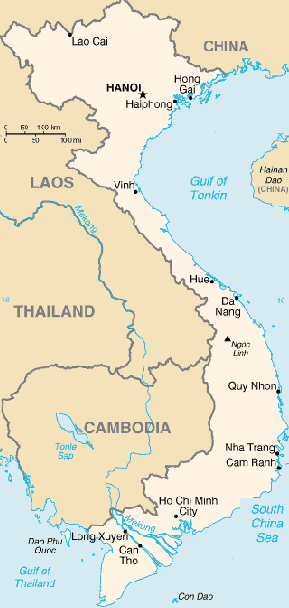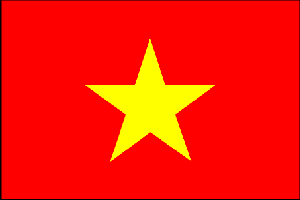
|

Vietnam
Background:
France occupied all of Vietnam by 1884. Independence was declared after World
War II, but the French continued to rule until 1954 when Communist forces under
Ho Chi Minh, who took control of the north, defeated them. US economic and
military aid to South Vietnam grew through the 1960s in an attempt to bolster
the government, but US armed forces were withdrawn following a cease-fire
agreement in 1973. Two years later North Vietnamese forces overran the south.
Location:
Southeastern Asia, bordering the Gulf of Thailand, Gulf of Tonkin, and South
China Sea, alongside China, Laos, and Cambodia.
Area: Total: 329,560 sq km, land: 325,360 sq km, water: 4,200 sq km.
Area - comparative: Slightly larger than New Mexico.
Land boundaries: Total: 4,639 km, border countries: Cambodia 1,228 km, China
1,281 km, Laos 2,130 km.
Coastline: 3,444 km (excludes islands).
Climate and Terrain:
Climate: Tropical in south; monsoonal in north with hot, rainy season (mid-May
to mid-September) and warm, dry season (mid-October to mid-March).
Terrain: Low, flat delta in south and north; central highlands; hilly,
mountainous in far north and northwest.
Natural resources: Phosphates, coal, manganese, bauxite, chromate, offshore oil
and gas deposits, forests, hydropower.
People:
Population: 81,098,416.
Ethnic groups: Vietnamese 85%-90%, Chinese, Hmong, Thai, Khmer, Cham, mountain
groups.
Religions: Buddhist, Hoa Hao, Cao Dai, Christian (predominantly Roman Catholic,
some Protestant), indigenous beliefs, Muslim.
Languages: Vietnamese (official), English (increasingly favored as a second
language), some French, Chinese, and Khmer; mountain area languages (Mon-Khmer
and Malayo-Polynesian).
Government:
Government type: Communist state.
Capital: Hanoi.
Independence: 2 September 1945 (from France).
Economy overview:
Vietnam is a poor, densely populated country that has had to recover from the
ravages of war, the loss of financial support from the old Soviet Bloc, and the
rigidities of a centrally planned economy. Substantial progress was achieved
from 1986 to 1996 in moving forward from an extremely low starting point -
growth averaged around 9% per year from 1993 to 1997. GDP growth of 8.5% in
1997 fell to 6% in 1998 and 5% in 1999. Growth then rose to 6.8% in 2000 and
dropped back to 4.7% in 2001 against the background of global recession. Many
domestic industries, including coal, cement, steel, and paper, have reported
large stockpiles of inventory and tough competition from more efficient foreign
producers.
GDP - composition by sector: Agriculture: 25%, industry: 35%, services: 40%.
Statistics:
Telephones - main lines in use: 2.6 million.
Telephones - mobile cellular: 730,155.
Radio broadcast stations: AM 65, FM 7, shortwave 29.
Radios: 8.2 million.
Television broadcast stations: At least 7 (plus 13 repeaters).
Televisions: 3.57 million.
Internet users: 160,000.
Railways: Total: 3,142 km.
Highways: Total: 93,300 km, paved: 23,418 km, unpaved: 69,882 km.
Airports: 34, with paved runways: 17, with unpaved runways: 17.
Return to Visiting Locations
|

